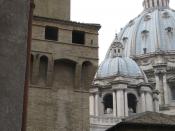Age of Discovery Architecture (1450-1750)
In the late Middle Ages of Europe, the stocky and thick-walled Romanesque architecture was very common. Architects used them in great projects such as fortifications, castles, monuments and cathedrals. However, these architectures were generally bulky and dark, as much of Europe relied on light from lamps or from the sun. Engineers had to consider many factors such as gravity and light for their constructions, thus limiting their creativity in building enormous projects.
In the 12th-13th centuries, advances in engineering permitted increasingly gigantic buildings. The rib vault, flying buttress, the pointed arch and other innovations were used as solutions to the problem of building a very tall structure while preserving as much natural light as possible.
These advances created Gothic ideas that gave rise to more graceful architecture. Verticality is emphasized in Gothic architecture, which features almost skeletal stone structures with great expanses of glass, pared-down wall surfaces supported by external flying buttresses, pointed arches using the ogive shape, ribbed stone vaults, clustered columns, pinnacles and sharply pointed spires.
Windows contain beautiful stained glass, showing stories from the Bible and from lives of saints. Such advances in design allowed cathedrals to rise taller than ever, and it became something of an inter-regional contest to build a church as high as possible.
Between 1400 AD and1600 AD, a return to classical ideas ushered an "age of awakening" in Italy and northern Europe called the Renaissance. This time period shifted architectures from building asymmetrical and ornate Gothic architectures to creating highly symmetrical and carefully proportioned buildings of Classical Greece and Rome. Orderly arrangements of columns, pilasters and lintels, as well as the use of semicircular arches, hemispherical domes, niches and aedicules replaced the more complex proportional systems and irregular profiles of medieval buildings. The increase in symmetrical perspective...


